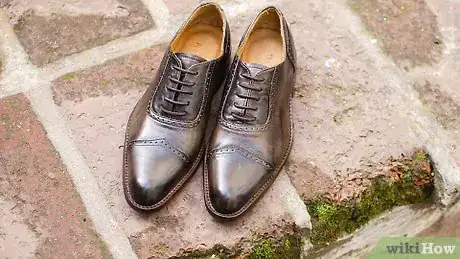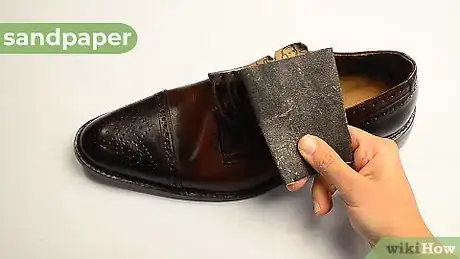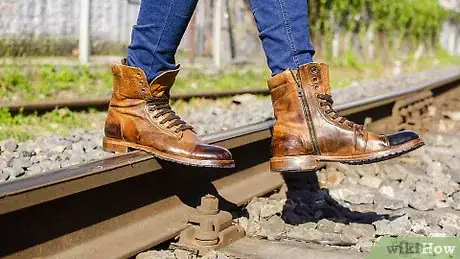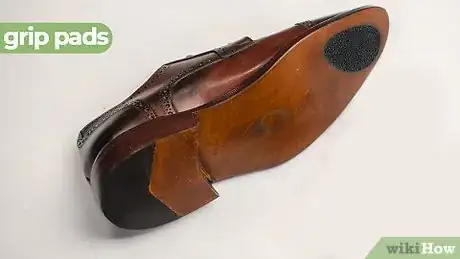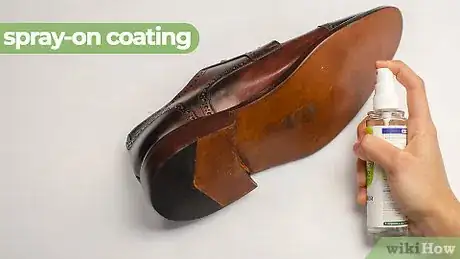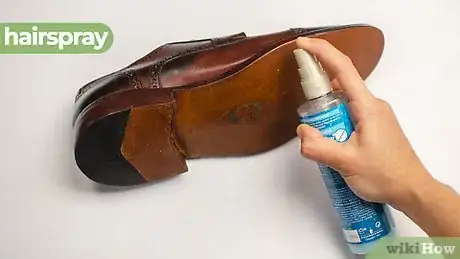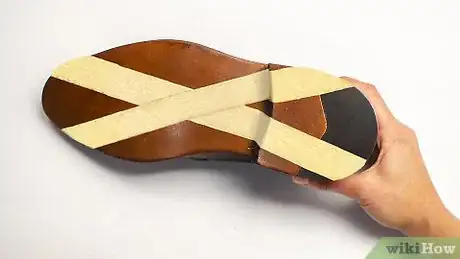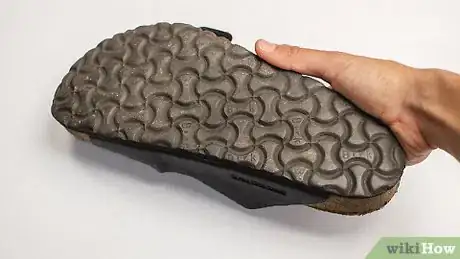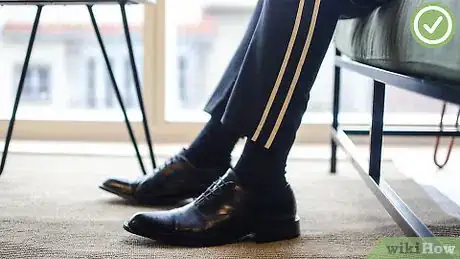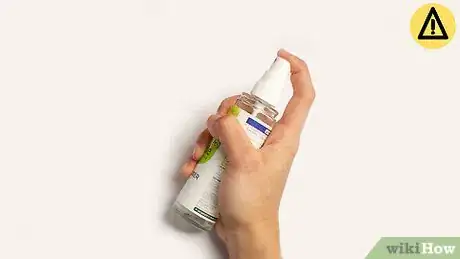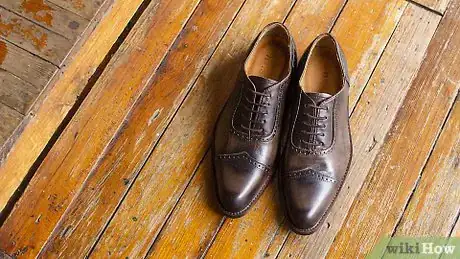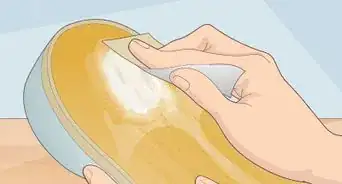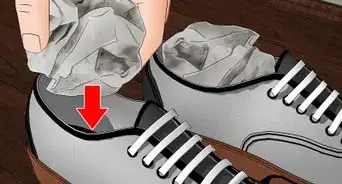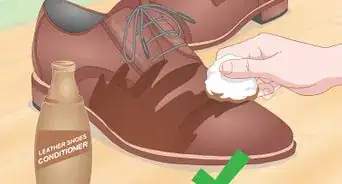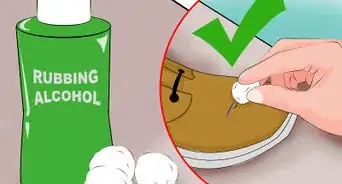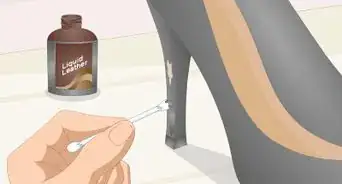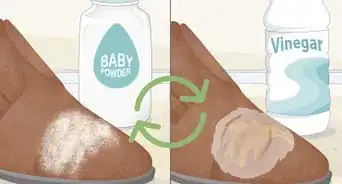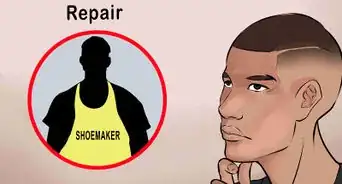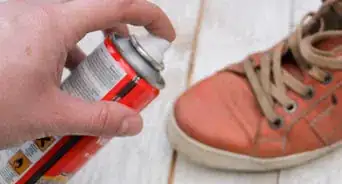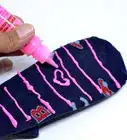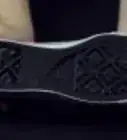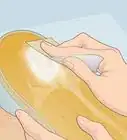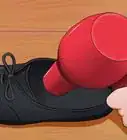This article was co-authored by Rio Jongsae Kim. Rio Jongsae Kim is a Designer Shoe and Bag Repair Specialist and the Owner of Kim’s Shoe & Bag Repair in Vancouver, BC, Canada. With over 40 years of experience, Rio and Kim’s Shoe & Bag Repair specialize in the repair and reconstruction of leather and luxury goods including shoes, handbags, and accessories. Rio’s experience and dedication to quality repair and restoration have led to his work being featured on Yahoo, Insider, and MSN.
There are 7 references cited in this article, which can be found at the bottom of the page.
wikiHow marks an article as reader-approved once it receives enough positive feedback. This article received 11 testimonials and 96% of readers who voted found it helpful, earning it our reader-approved status.
This article has been viewed 979,975 times.
New shoes, especially those with plastic or leather soles, can have frustratingly slippery soles, as can older shoes that are worn smooth by years of wear and tear. As minor as it may sound, having slippery shoes isn't just an inconvenience — it's actually a major cause of injury, with over one million reported slip, trip, or fall injuries each year in the U.S. alone.[1] However, you don't necessarily have to toss out a slippery pair of shoes: with just a few simple tricks, it's usually easy to put some grip back into your shoes for dirt cheap!
Steps
Breaking In New Soles
-
1Scuff the soles on abrasive surfaces. If your slippery shoes are a new pair, there's a good chance that they're slippery simply because their soles are perfectly smooth and unworn. Soles generally get a little more grip once they soften and small nooks and abrasions have been worn into them because these properties allow them to make better contact with the floor. Thus, wearing your soles down somewhat can often noticeably improve your traction.
- To do this, try walking around on a rough surface like, for instance:
- Concrete (the rougher, the better)
- Gravel
- Rocks, boulders, etc.
- Textured metal grates, walkways, etc.
- If you're not embarrassed, you can even try taking your shoes off and scuffing their soles on the ground with your hands.
- To do this, try walking around on a rough surface like, for instance:
-
2Abrade the soles directly with sandpaper. Aren't in a situation where you can easily scuff your shoes on a rough surface? Worried about slipping while you're waiting for your soles to wear down? Try an abrasive like sandpaper instead — simply take off your shoe and rub the smoothest parts of the sole that touch the floor until they develop a rougher, more textured feel.
- For this task, a fairly coarse sandpaper is best, though finer sandpapers are better than nothing. If possible, use about a 50-grit paper.
- Note that this may not work on certain soles, especially those with a "natural," cardboard-like texture (as is often used for some sandals and flats.)[2]
Advertisement -
3Use a nail file. If you don't have sandpaper, a nail file or similar tool usually works well. Use it exactly like you used your sandpaper — scuff the smooth, flat parts of your shoe that come in contact with the floor to give them some texture.
- Metal files are typically the most durable, convenient tools for this task, though even simple emery boards can work. As with sandpaper, coarser files work best here.
-
4Wear your shoes and wait for the soles to naturally wear down. Another way to make your shoes less slippery is to simply wear them as much as you can. Over a few days to a few weeks of use (depending on how often your wear your shoes), the simple action of walking should take the slickness out of your soles.
- If you use this method, take care to switch to a different pair of shoes whenever you anticipate a situation where slipping is likely (like dancing, walking in the rain, and so on.) You don't want to risk hurting yourself simply to make your shoes more wearable.
Using Grip-adding Products
-
1Invest in grip pads. If your slipping problems are coming from an older pair of shoes, the issue may not be that your sole isn't worn enough, but rather that it is too worn. In this case, you may want to consider adding material to the bottom of your shoes to give you more grip. Perhaps the most "professional" way to do this is to apply shoe pads designed specifically for this purpose to the soles of your shoes.[3]
- These textured pads typically attach to the material of the sole with an adhesive. Note that some users complain that this adhesive can leave shoes with a "sticky" feeling once the pads come off.
- Grip pads are sold at many higher-end wardrobe supply stores for fairly cheap — usually no more than $10 or so for a single set.[4]
-
2Alternatively, buy a spray-on coating. In addition to adhesive pads, there are also spray products designed to be used on the soles of shoes to give them more grip. These products, usually sold as "traction sprays" or "grip sprays," can vary in quality, so talk to an employee or spend time reading customer testimonials before making a purchase.
- Traction sprays are usually sold at the same places at grip pads for a slightly higher cost — usually about $10-20.
-
3Use hairspray. Don't want to spend money on traction-adding products? Several products that you probably already have in your own home may also give good results. However, it's important to note that these improvised solutions are not guaranteed to work as well as the professional ones above. One home remedy is hairspray — simply spray a generous coat on the soles of your shoes for a little extra "stick" (especially on smooth-bottomed dress shoes.) Give the hairspray at least half a minute or so to dry and become tacky before walking in the shoes.
- Keep in mind that this solution is temporary and will require re-application. In addition, hairspray may rinse off in wet weather.
-
4Use puff paint. "Puff" paint (also called "dimensional fabric" paint) is a type of paint that's frequently used in arts and crafts products for children like making tee shirts. When puff paint dries, it gains a somewhat rough, textured quality, making it a good choice for adding grip to the bottoms of shoes. Simply apply a thin coat to the sole, leave the sole for a few hours to dry, and test out your solution!
- While puff paint should last longer than hairspray, it will need to be re-applied semi regularly for maximum effectiveness.
- If you have the time, consider painting a design into your shoe — it's a great way to make your shoes truly unique and express your creativity.
-
5Use masking tape. One simple "last resort" technique for improving the traction of your shoes is to simply stick a few pieces of masking tape on their soles. Lay two strips of tape in an "X" pattern on the widest, flattest parts of your soles for maximum effect.
- Be aware that, as the tape loses its adhesive quality, you may need to add more masking tape.
-
6For high-quality shoes, consider seeing a shoe repairer. If you've got a pair of shoes that is especially expensive or that you treasure too much to modify with the tricks above, consider bringing it to a professional cobbler or shoe repairer. These professionals may be able to fix your shoes by modifying or replacing their soles.[5]
- Note, however, that the services of a cobbler often do not come cheap. Depending on the quality of your shoe and the difficulty of the work being done, a single pair of shoes can cost over $100 to fix.[6] Thus, this solution is best saved for your very nicest pair of shoes.
Knowing What to Avoid
-
1Check before wearing your improvised non-slip shoes to work. Many jobs (especially those in restaurants) have workplace rules that require employees to wear specially certified non-slip shoes. If your job has this rule, don't wear shoes that you've modified with one of the tricks above in place of actual non-slip shoes without checking with your employer first. Doing this may be violating your job's code of conduct. More importantly, however, it may leave you vulnerable to injury — non-slip shoe requirements exist for a reason.
- When in doubt, simply get a new pair of non-slip shoes. Note that most non-slip shoes are rated with a scale called the "coefficient of friction" (CoF). For most jobs that require non-slip shoes, a coefficient of about 0.5-0.7 is ideal (check with your employer for rules specific to your job.)[7]
-
2Don't wear your shoes out without testing them somewhere safe. If you're testing out a new traction-adding technique for the first time, don't put yourself in a situation where you'll need it until you've tested it out. Taking the time to do something as simple as walking around your house or making a trip around the block can sometimes tell you all you need to know about how effective your solution is.
-
3Don't use sprays or adhesives that are unsafe for your shoe material. If you're dealing with a pair of shoes made from a fine material like leather, be sure to check the packaging for any products you intend to use on them before doing so. Though problems are likely to be rare, some products may cause certain shoe materials to discolor or degrade, making them a very bad choice.
- For example, the chemicals in hairspray have been known to damage certain types of leather, which means that care must be taken if using hairspray as a temporary fix for a slippery pair of leather shoes.[8]
-
4Don't rule out a new pair of shoes if the problem is severe. The methods in this article aren't perfect and may not work for shoes that are very slippery. While it can be tough to say goodbye to an old pair of shoes that have permanently lost their grip, the alternative — a nasty slip and fall — is worse. If your shoes' soles are truly beyond hope, stop wearing your shoes and look for a new pair.
- If your shoes are still in reasonable condition but are too slippery for your work or hobbies, consider donating them to a charity like Donate Your Old Shoes. This way, someone else may be able to get use out of your shoes, even if you cannot.
- Also try using a Pedi-egg product and scuff the souls vigorously.
Expert Q&A
-
QuestionWhat's the most efficient way to get my shoes as grippy as possible?
 Rio Jongsae KimRio Jongsae Kim is a Designer Shoe and Bag Repair Specialist and the Owner of Kim’s Shoe & Bag Repair in Vancouver, BC, Canada. With over 40 years of experience, Rio and Kim’s Shoe & Bag Repair specialize in the repair and reconstruction of leather and luxury goods including shoes, handbags, and accessories. Rio’s experience and dedication to quality repair and restoration have led to his work being featured on Yahoo, Insider, and MSN.
Rio Jongsae KimRio Jongsae Kim is a Designer Shoe and Bag Repair Specialist and the Owner of Kim’s Shoe & Bag Repair in Vancouver, BC, Canada. With over 40 years of experience, Rio and Kim’s Shoe & Bag Repair specialize in the repair and reconstruction of leather and luxury goods including shoes, handbags, and accessories. Rio’s experience and dedication to quality repair and restoration have led to his work being featured on Yahoo, Insider, and MSN.
Designer Shoe & Bag Care Specialist Take them to a cobbler or a shoe repair professional. They'll be able to make custom changes to your shoes so they fit more comfortably and grip better.
Take them to a cobbler or a shoe repair professional. They'll be able to make custom changes to your shoes so they fit more comfortably and grip better. -
QuestionWhat's a cheap way to make my shoes grippier?
 Rio Jongsae KimRio Jongsae Kim is a Designer Shoe and Bag Repair Specialist and the Owner of Kim’s Shoe & Bag Repair in Vancouver, BC, Canada. With over 40 years of experience, Rio and Kim’s Shoe & Bag Repair specialize in the repair and reconstruction of leather and luxury goods including shoes, handbags, and accessories. Rio’s experience and dedication to quality repair and restoration have led to his work being featured on Yahoo, Insider, and MSN.
Rio Jongsae KimRio Jongsae Kim is a Designer Shoe and Bag Repair Specialist and the Owner of Kim’s Shoe & Bag Repair in Vancouver, BC, Canada. With over 40 years of experience, Rio and Kim’s Shoe & Bag Repair specialize in the repair and reconstruction of leather and luxury goods including shoes, handbags, and accessories. Rio’s experience and dedication to quality repair and restoration have led to his work being featured on Yahoo, Insider, and MSN.
Designer Shoe & Bag Care Specialist There are these products called "anti-slip sole stickers" that you just attach to the bottom of your shoes. They're pretty effective!
There are these products called "anti-slip sole stickers" that you just attach to the bottom of your shoes. They're pretty effective! -
QuestionWhat do I do if my shoes are Converse?
 Community AnswerThere are many good solutions in this article that can apply to Converse shoes. You could also buy a set of those stick on rubber decals for your bathtub (used to make it safer) and place them on the soles.
Community AnswerThere are many good solutions in this article that can apply to Converse shoes. You could also buy a set of those stick on rubber decals for your bathtub (used to make it safer) and place them on the soles.
References
- ↑ https://www.edgarsnyder.com/slip-and-fall-accidents/slip-fall-statistics.html
- ↑ http://patch.com/pennsylvania/radnor/bp--the-gift-of-grip-the-fix-for-slippery-shoe-soles-065166f3
- ↑ Rio Jongsae Kim. Designer Shoe & Bag Care Specialist. Expert Interview. 15 April 2021.
- ↑ http://www.wardrobesupplies.com/categories/shoe-care/more/shoe-rubber-and-no-slips
- ↑ Rio Jongsae Kim. Designer Shoe & Bag Care Specialist. Expert Interview. 15 April 2021.
- ↑ https://www.thebillfold.com/2013/10/how-much-should-it-cost-to-fix-my-shoes/
- ↑ http://warestaurant.org/blog/should-my-restaurant-have-a-non-slip-shoe-policy/
- ↑ http://www.fibrenew.com/blog/do-not-use-hair-spray-to-fix-leather-upholstery-alcohol-damage-olive-oil-beeswax-markers/
About This Article
To make a new pair of shoes less slippery, start by rubbing coarse sandpaper or a nail file directly on the sole to create a rougher, more textured feel. Alternatively, you can scuff the soles on abrasive surfaces like concrete or gravel to improve traction. If your slipping problems are due to an older pair of shoes, try adding adhesive grip pads to the bottom of the shoes. You can also try adding more grip to the soles by brushing on a thin coat of puff paint, which you can find at your local arts and crafts store. For more tips, like how to use hairspray to make your shoes less slippery, read on!
